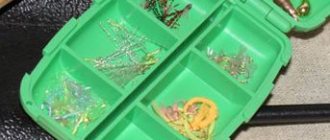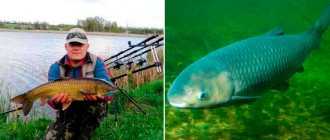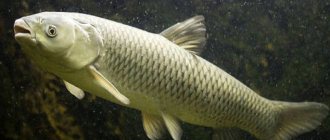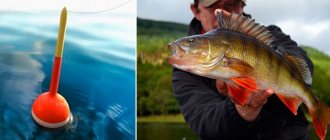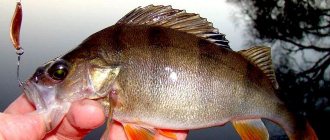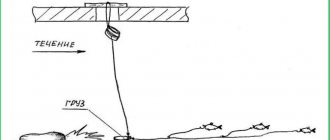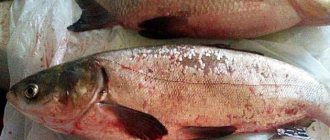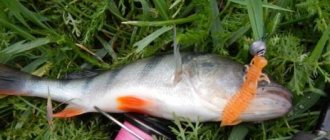Many winter fishing enthusiasts are looking forward to the sea bringing in ice floes, welding them together and providing a reliable frozen mirror for searching for one of the favorite prey of local residents - smallmouth smelt. Among Sakhalin fishermen, the fish is known under other names. It is often called “small mouth”. Smelt has a high nutritional value, which is why whole families go out on the ice.
Preparing equipment
The first step is to assemble the rod. Winter fishermen use a variety of types of fishing rods: from classic models with a wooden handle to modern forms for catching predators. Smallmouth live in large schools, so fishing for them is not difficult. The rod must withstand a load of 10-15 gram sinker. The tiny fish has a small mouth, so the softness of the whip plays an important role. When hooking, you need to cut through the lip, and not pull out the bait, as they say, “with meat.”
Fishing rods are equipped with small inertial, less often inertial-free reels. At great depths, the second type is preferable, since such reels have a high line reeling speed. An inertia-free reel significantly increases the weight of the tackle, but simplifies the procedure for moving between holes. When the fish is active and there is no need to look for it, then lightweight inertial products come to the fore.
Smelt does not reach impressive sizes, so a fishing line diameter of 0.1-0.16 millimeters is enough to catch it. When fishing, several specimens often land on a “garland”, so you need to fish them out with caution. There is also the possibility of catching larger prey, such as navaga.
Read: Catching roach in December
Thick monofilament has several important advantages:
- Fishing in severe frost. Experienced ice fishermen know how difficult it can be to untangle thin line, especially when your fingers start to freeze. A thick section is subject to loops and knots much less often, so it is easier to work with such tackle.
- Significant elasticity. In case of a sharp bite on a sudden trophy, the stretchability of the winter fishing line will not allow the fish to tear off the garland. A kind of shock absorber will dampen all jerks of the brisk prey.
- High breaking load. The higher the diameter of the monofilament, the stronger its structure. Of course, a thick line penetrates the water column worse, but a larger sinker can solve this problem.
- Abrasion resistance. There are often cases when the fishing line is damaged by the sharp edges of the hole or frozen slush that lies on the ice.
A garland of decoys is used as bait. Installation looks very simple: at the very bottom, using a blind loop, hang a drop-shaped sinker. A garland is mounted a little higher than the lead. The distance between leashes varies from 15 to 30 centimeters. A large number of hooks makes it possible to determine on what horizon the accumulation of smelt is located.
A little about the garland
The piece of fishing line on which the leashes are located is 1.5-2 meters. On average, 5-7 hooks of red, blue, gold or silver are used. They are attached to 2-centimeter leashes, which, in turn, are mounted using the “loop-to-loop” method. This approach makes it possible to quickly replace a torn hook, which is not so rare.
Read: Catching perch with lures in winter
You can tie the garland yourself; for this you will need a set of hooks and a roll of fishing line. The bait will be maggots or finely chopped fish. If you don’t want to make tackle with your own hands, then factory analogues of Japanese and South Korean brands will come to the rescue. Their price is sometimes high, but the garlands fully live up to expectations, working without bait. Decoys can be silicone or thread; lurex and various glitter are also often used. The main task of the bait is to high-quality imitation of underwater inhabitants: crustaceans, insects and their larvae.
The bite is noticed by the guard, the tip of the rod or the float. The floating alarm also prevents the leads from getting tangled, preventing them from sinking to the bottom. Many anglers use several rods at once, holding them in each hand. Refined fishing techniques allow you to achieve results much faster. The game looks like this: short swings are replaced by small swings. A simple animation catches fish perfectly throughout the freeze-up period.
Ice cucumber
Thousands of fishermen these days go out on the ice of lakes in the southern part of Sakhalin. They are not afraid of the cold and the danger of plunging into a cold plunge pool - the smallmouth bite! And that's it. For those who understand, of course.
Smallmouth smelt live in abundance in the Busse lagoon, lakes Izmenchivoe, Tunaicha and others connected to the sea, as well as the mouths of the large rivers Naiba, Lyutoga, Poronai. A distinctive feature of the smelt genus is the rather strong smell of fresh cucumbers emanating from a fish just taken out of an ice hole.
Preparing gear
To catch smallmouth, first of all, you will need an ordinary winter fishing rod. A thick fishing line is of no use here; you shouldn’t expect violent resistance from a small fish, so a fishing line with a cross-section of 0.1-0.15 millimeters is quite suitable. Let's take a small sinker, the size of a small olive. The whole trick of the gear lies in the so-called garland. Having retreated about 20 centimeters from the sinker, short, several centimeters, leashes with hooks are tied to the main line. The size of the hooks depends on the fish to be caught, so in our case the most popular ones are red with numbers from 3 to 5. The distance between the leads should be 15-20 centimeters. Usually 6-7 leashes are tied. However, smallmouth fishing in Sakhalin lakes often occurs at depths of just over a meter, so fewer leashes with hooks will be needed. The bait for such gear is usually maggots, which can be bought at any fishing store.
However, those who do not like to knit their own cordage can purchase ready-made garlands made in Japan or South Korea. They do not require bait. Its role is played by a bait made of silicone, imitating small sea crustaceans - krill and other aquatic life.
It is difficult to judge which gear promises rich catches. It all depends on the weather, the fishing location, and also, so to speak, the mood of the fish itself. Therefore, fishermen who do not want to return from a pond empty-handed take several types of garlands with them, perhaps one of them will attract the attention of smelt.
Many fishermen consider a float an essential element of their gear. It not only signals a bite, but also prevents the garland from completely sinking to the bottom and getting tangled. However, some fishermen do just fine without a float; they easily notice a bite by the vibration of the line and the tip of the fishing rod.
On the ice!
Residents of Yuzhno-Sakhalinsk go fishing early in the morning in order to reach the fishing spot before dark. Smelt fishing is very popular among the island's residents. Therefore, families often go fishing.
So here we are. Most fishermen, not versed in the intricacies of underwater currents and the peculiarities of fish behavior, choose a place for fishing, focusing on clusters of other fishermen. There is some truth in this, but we should not forget about the ethics of behavior. For example, you should not drill a hole too close to a more successful angler. Very often this leads to the fact that the fish, frightened by the noise and bustle above, leaves and the bite stops.
The holes have been drilled and the gear has been installed. To make fishing more comfortable, many fishermen use lightweight, portable tents. A tent without a bottom is installed above the holes and then the fisherman is protected from the wind. And if you light a primus stove or gas stove inside and boil a kettle, it will be warm, just like at home.
If you don't feed, you won't catch
The fishing rod should be held in your hand so that the sinker touches the bottom. Regularly, every few seconds, gently raise the fishing rod. A bite will be signaled by a float or an unexpected change in the weight of the sinker and garland at the moment of lifting.
The hook should not be sharp or very strong. Smelt is a delicate fish, and a strong tug will only knock the hook out of its mouth, and you will be left without prey.
Eat! We quickly select our tackle - and now the first silver fish is striking on the ice, spreading the unforgettable smell of fresh cucumbers around it.
If the smelt does not bite at all or reacts sluggishly to the bait, it is worth using bait.
Fresh krill is considered the most effective. A tablespoon of small crustaceans thrown into a hole can attract a large school of smelt.
However, often ordinary semolina is no less effective bait. A handful of this cereal is thrown into the hole. You can even use canned saury in oil as bait.
It smelled fried
If the day is successful, the catch could amount to several hundred fish.
The most delicious smelt is fried with mashed potatoes or boiled rice as a side dish.
Preparing this dish is not difficult even for complete amateurs in the art of cooking. There is no need to remove scales from the fish. It is enough to cut off the head, tail and remove the entrails. Some fans don’t do this either; they think that whole fried fish tastes better.
Roll the smelt in flour mixed with salt and black pepper and fry in a frying pan with plenty of butter until golden brown. After this, steam the fish for several minutes under the lid. You can set the table. Bon appetit!
direct speech
Vitaly Nikitin,
Acting Head of the Laboratory of Freshwater and Coastal Fishes of SakhNIRO:
— There are three species of smallmouth smelt on Sakhalin. Amateur fishermen mainly catch smallmouth smelt. This is the largest fish, reaching a length of about 20 centimeters. The color is silver with a purple tint. Local residents gave it their name - typhoon. Its bite, starting from the freeze-up period, will last, fading, until January. A new outbreak of biting associated with the upcoming spawning will occur in mid-March.
A little smaller is the common smallmouth smelt. Usually it is no larger than 12-14 centimeters. Its color is slightly yellowish with gray. And the third species is the smallest - anadromous smallmouth smelt. It has a silver-violet color.
Smallmouth smelt populations on Sakhalin are in good condition. The fact is that they are not of great interest for fishing; the total allowable catches for this type of aquatic biological resources are not fully developed. And amateur fishing does not cause any noticeable damage to populations.
Department of Fisheries of the Sakhalin Region - 693011, Yuzhno-Sakhalinsk, Kommunisticheskiy Ave., 39.
Tel..
Common smallmouth smelt (Hypomesus olidus (Pallas, 1814))
The body is runaway. The caudal peduncle is low. The mouth is small. The teeth are numerous and small. The color of the back is greenish-gray, the sides are silver. The fins are light. The connection of the air channel with the lower part of the swim bladder is not located at the anterior end of the swim bladder, but is shifted some distance away. A characteristic that allows it to be distinguished from the Japanese smallmouth smelt (Hypomesus nipponensis).
Aboriginal species. The range includes the flat parts of the Lower and Middle Amur basins up to the village. Albazino, along the river. Zeya - to the Zeya Reservoir, where it is common. There is in the river basin. Nora up to the river. Meun. Along the river Ussuri is observed up to the city of Lesozavodsk, and was previously noted along the river. Sungach up to its source from lake. Hanka. In the lake Hanka smelt apparently does not live there. However, in the Lower Amur basin it inhabits large lakes, including those remote from the Amur (Lake Chukchagirskoye and Lake Bolon).
Outside the river basin Amur is distributed along the Arctic coast of Asia from the Kara Sea to the Bering Strait. Along the American coast it is distributed east to the river. Mackenzie, as well as in the North Pacific Ocean south to Hokkaido Island, northern Primorye and Alaska. In the river basin Cupid forms a passage and residential form. Residential smelt live mainly in large lakes, but are also found in the Amur riverbed. It becomes sexually mature in the second year of life with a length of at least 4 cm.
Commercial significance
Numerous species in the lower reaches of the Amur and its estuary. The number is subject to large fluctuations under the influence of natural factors. Important commercial species. In the lower reaches of the Amur it is a traditional object of industrial, as well as amateur and sport fishing. Over the last decade, the maximum catch was recorded in 2021. Then it amounted to 2110.0 tons.
The role of small smelt in the life of other Amur fish
Small smelt is of considerable importance in the nutrition of Amur fish. On the one hand, it feeds on the same food as juveniles of other fish. In this case, a change in the number of its juveniles is unlikely to affect the nutrition of the juveniles of other Amur fish. Simply put, juvenile smelt does not “eat” juveniles of other fish. On the other hand, the smelt itself is a food source for predators. In years when there is a lot of smelt, it is the food source for bleak, redfish and yellowjacket, as well as rudd, asp, pike, Amur catfish and Chinese perch. The last 5 species feed on smelt in summer only at low water. In high water, only pelagic predators feed on smelt.


